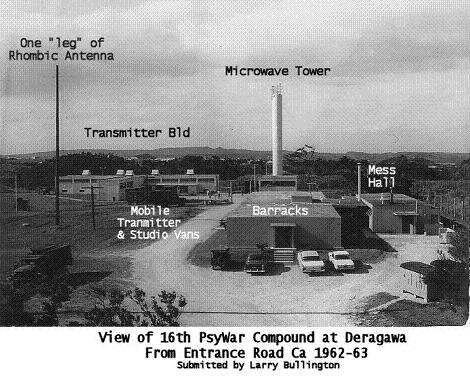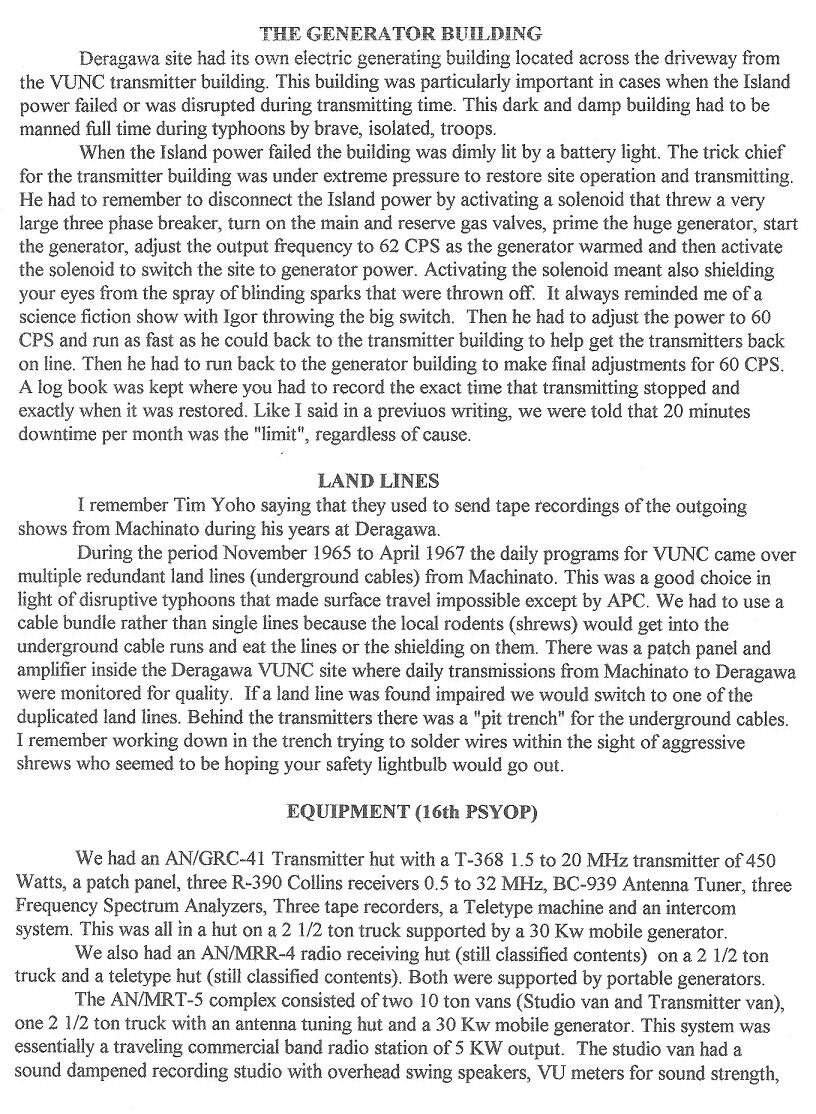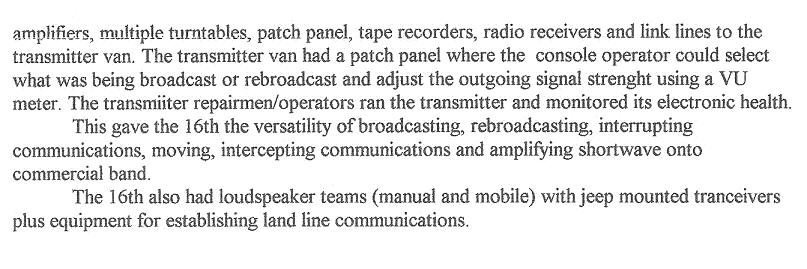
I entered the Army on April 1, 1965 as a draftee. Taking a year off from college to work and save money to go back did not work out because these were the Vietnam War years. The Army physicals in Chicago were a joke at that time and the primary criteria must have been if you were breathing on your own. So here I was with flat feet, bad eyesight, not great hearing, hernia and a heart murmur going off to be a soldier with a 1-A rating. Luckily I had 7 years of electronics and Ham experience.
Basic training was two fun filled months at sunny Fort Knox followed by 4 months at the US Army Signal Corps Training School at Fort Monmouth New Jersey. Private John Lagowski (from Milwaukee) and I did not even get to attend our graduation as MOS 272's (Fixed Station Transmitter and Carrier Equipment Repairmen) because we both got "Sealed Expedite Orders" to a classified destination. We were whisked away by staff car that took us for shots and immediate out processing, then off to an air flight out of New York. Based on the kinds of exotic shots we got and the fact that our flight was to California it was kind of obvious that we were not off for a fun tour of Europe. arriving at Oakland Navy Terminal we surrendered our sealed envelopes and jointed the tens of thousands of troops awaiting transport. We still had no idea of where we were going.
We found that there is a big difference between Army "Expedite" and Navy "Expedite". Navy "Expedite" turned into a 21 day troop ship ride in the Pacific. About two days out of Hawaii both of us were brought into the Ship's Captain and asked to explain why we were on his ship. We explained that the Navy ordered us to get on. What did that idiot expect us to say? After several radio calls it was determined that the Navy would not transfer us o a helicopter with a boatswains chair and we would remain on the ship. Overall it was a decent trip except for the typhoon we hit.. Lagowski and I had rank on almost all 3000 troops being trnsported so we were made into MP's and pulled two shifts of guard duty every day. We still had no idea where we were going.
Our first view of Okinawa was the Northern part of the Island with Mount Hedo sticking out of a late November sunrise and two jets to Vietnam from Kadena Airbase making about a ten foot high close pass on each side of the ship. a loud speaker announced that we were approaching Okinawa and to go below and get our duffel bags ready. We departed the USNS Barrett MATS transport at Naha, Okinawa. We were ordered to take a small bus that dropped us off at the 7th PSYOP Headquarters at Machinato where we were told to report.
The first sergeant at the 7th was glad to see us because they were going for "live fire" the next day and he needed guards for a guard mount to stay up all that night and patrol "Bolo Point", the firing range. Gee, we were hoping to fit right in and we sure were! The next morning we were returned to Machinato and told that a mail jeep would soon be taking us to another destination.. We still had no idea were we going or supposed to be doing.

PFC Rodney Bent picked us up and in his laid back fashion of the 16th Company told us to "throw your shit in the jeep". We made a few stops and then made the trek up through Kadena, Koza, Teragawa and way up to the Deragawa site. The site was exciting to me as an electronics nut and I knew that antenna field, those transmission lines and the radio tower meant good news...."Hey, a transmitting site....YES!" After the preliminaries of reporting in we were told that we were replacements and were 3 week late.
We were assigned quarters and found them to be very good with only 2-3 men per small room! NCO's got single rooms! This was fairly gracious living compared to the large bays found in typical Army barracks. We discovered that the site was actually built by the Airforce.
The company was making the transition between being a component of 14th PSYWAR Battalion and the newly reorganized 7th PSYOP Group. Mostly everything at Deragawa was not formal and the main instruction was to do your job and keep your mouth shut about what you did to everyone.
I was first assigned to the AN/MRT-5, a 5000 watt transmitter in a 10 ton van with a companion 10 ton studio van. The mobile unit also consisted of a 30 KW generator and an antenna tuning van under SSGT Ira Coston.. (EDITOR: This was the same equipment I was assigned to). .We also had an AN/GRC-41 ("ANGRY-41") transmitting van with loads of radio gear plus teletypes on a 2 1/2 ton truck and an AN/MRR-4 receiving van also on a 2 1/2 ton truck. The transmitter in the AN?MRT-5 had been unavailable for service due to failure of the power supply and patch panel problems. Coston and I had a lot of fun bringing the transmitter back into operation.
The 16th Company had a second arm that was comprised of both pole/antenna climbing, mobile transceiver and mobile speaker teams. They used the standard jeeps and two wheeled trailers. (NOTE: This unit was known as the 18th Detachment in 1963 EDITOR).
The 15th Detachment (Strat.) had a VUNC section of the Deragawa Site that had two big Collins high frequency transmitters. VUNC was operated in support of initiatives in Asia and operated 24/7 as a relay. (NOTE: To my knowledge, the presence of the 15th at Deragawa was a change from 1963. I also worked in this site that was operated and maintained exclusively by 16th Company personnel. The VUNC studios were in Machinato and tapes of programs were sent to Deragawa for transmission to China, Korea, and Vietnam. EDITOR)
The VUNC Site had two primary buildings: the transmitter building and a 300 Kilowatt Cummins Diesel Generator building.
The day began with maintenance and checking all the hourly meter readings from the transmitters for trends that may indicate a problem. about 2 PM the transmitters were fired up so that the power supply bays of the transmitters were stable and ready for a 3 PM staged startup. The transmitters were fired up one stage at a time and had to be tuned as they were brought up.....Lets see...do you max the grid and dip the plate or do you dip the grid and max the plate voltage......That's a tranmitter joke folks!
Transmitting continued the rest of the day into the next day. The transmitting day ended with a 7 AM transmission of Voice of America that came over underground transmission lines. Each 8 hour shift consisted of a "Trick Chief" (normally an NCO) and one to two specialists (Fixed Station Transmitter Repairmen). The Trick Chief reported to a sergeant E-7 during my tour. We worked 9 days on 3 days off (if you were lucky) on swing shifts of 3 days each. We were told that anything over 20 minutes downtime in a month and your next broadcast would be from the Bering Straits. It was tricky once in a while because the island power was undependable and all of a sudden the lights would dim and a Trick Chief (like me) was at a dead run to the generator building.
The 15th and 16th shared the barracks and were intertwined in daily life. Several people, myself included changed off between the 7th Group HQ, 15th Detachment, 16th Company, transmitter team, receiver and loudspeaker teams. This exchange was mostly necessitated by filling in for people on TDY.
The AN/MRT-5 transmitter had a 180 foot radio tower which was unassembled in a large stack of wooden boxes ready for deployment. It was stashed in Papasan's house next to the gate. 1st Lt. Paul Westerlind suggested we should practice putting it up but we determined it was a one way operation. Once built it was relatively permanent. Another drawback of a 180 foot radio tower is that it is hard to carry and difficult to hide. It seems to defeat the purpose of a mobile, rapid deployment radio station attached to a big honking antenna bolted down by wires. We opted to use the WWII barrage balloons to carry a straight wire antenna aloft during practice broadcasts. This worked very well but made a nightmare out of the Antenna Tuner Shack. Imagine entering a shack but the lights are on even with the light switch off. The lights were on because of a mismatch between the balloon's wire and the tank circuit of the transmitter. That had to be corrected by us! Fun times, make a mistake and you are either baked, dead, or sterile.(In 63 one of the Okinawan houses near the Rhombic Antenna also had their lights on all the time because of radiation from the antenna: EDITOR)
During 1965 to 1967 many of the Deragawa Site personnel were sent TDY to Korea, MACV (Vietnam), and other countries
In 1965 we had a Mascot dog named Karen.. She provided many litters of puppies to the okinawans near the site. In 1966 she had one puppy we kept. His name was Duddly. he was very attached to the First Sergeant and followed him around. Physical coordination wa not his specialty and many days he fell down the front steps at morning formation.
1640 on the AM dial was the allocated frequency for the 16th PSYOP "Voice of Karen". Karen was our mascot dog at the site. This was a training program put on in 1965-67. Most time we broadcast locally using a "dummy load" to absorb most of our output. We put on interviews, music and even broadcast a few ball games from an orphanage. Sometimes we would deploy the ANGRY 41's T-368 transmitter as a moving transmitter of about 450 watts at high frequency and receive it at a fixed location with the AN/MRT-5 and amplify it to 5000 watts on the AM band. We did many exercises to practice different deployment conditions.
The report of "Karen" really suprised me and actually brought tears to my eyes. We found Karen in a jeep engine compartment shortly after Typhoon Karen hit the island in 1963. One of my friends Jay Eubanks started the engine for a mail run to Machinato and heard an animal squeal and immediately shut off engine and looked under the hood. There he found Karen, a 4-6 month old female puppy, slightly damaged by the engine fan blade. She was immediately adopted by the unit as our mascot and was beloved by all. I always wondered what happened to her and was very pleased that she was still part of the unit in 1966-67: EDITOR
During 1965-67 we provided training to Free World Forces and First Special Forces on Okinawa. a one week field mission established Typhoon Early Warning communication for the remote fishing village of Ada, in far northern Okinawa, by members of the 16th.
One of the better features of the 16th was professional KP's. Money was taken out of our pay for KP's, a houseboy who did boots and kept the hall orderly and later a gardener (an unemployed man who once asked for a job at the gate). I read the earlier accounts of Deragawa stie about laundry and bed making but we did not have that.
Most days there was a 4 PM volley ball game. At times there were in-ranks runs to the main road and an open run back. The volley ball was a rock' em sock' em game with every rank including NCO's playing. We had a few baseball games over the years but since the base was so small it was hard to get enough people. We did have a horseshoe pit.
We were strongly encouraged to join the pistol shooting team and some did participate on weekends if their job permitted. (EDITOR: In 1963 we had both a small and large bore rifle team)
We were strongly and vigorously encouraged to go Airborne if we were not already. Since the First Sergeant was Airborne and the unit was Airborne it was a wise and prudent thing to do. A blanket party was the site reward for getting your rating.
The 16th was allocated a flagpole in late 1966 or early 1967. Unfortunately we did not have a flag at that time. When we had ceremonies we just saluted the pole! God please forgive me for laughing. Actually some of the guys found uses for it and i remember more than once seeing women's undergarments flying proudly from it. We had one big weekend waterfight in 1966 and Sp4 Hack ended up handcuffed to it with shorts full of ice.
Halloween 1966 was a fun day. some of the guys built a coffin and it carried Dave Oganowski (from Connecticut) and others. They went from bar to bar, first toasting their dead comrade in the coffin and then the dead man would sit up in the coffin and say "IIIMMMMTHHIRRSTEEEE". That pretty well cleared the bars of all the "B" girls and even the bartenders. Spirits of the dead were fairly unpopular on Okinawa.
The dayroom was our clubhouse and was closed for a long while in 1966 being used as a supply room. It was refurbished and reopened about November 1966.. The bar was renamed "Coffin a Go-Go" and was the permanent resting place of the Haloween coffin. I think it opened only after 6 PM and was on the honor system to pay for a beer from the fridge. (Our group in 1963 renovated and equipped this quonset hut in 1963 for use as a club: EDITOR)
New Years Eve 1966 started out as a festive ocassion. The big gag was to tear someone's T-shirt off while they were wearing it. Hey, you make fun where you can! All too soon it turned kind of somber in that most guys had been out of the US for their second year. it wasn't all fun and games.
The nature of inspection at the 16th shifted from IG in 1965 to Operational Readiness in 1966. The impact shifted rom "is it clean" to "does it work" and "is it combat-ready". Late 1966 and early 1967 included several "pack it up and move out" exercises. One of my final assignments was to assist writing a reverse packing list (which truck with which equipment and spare parts gets loaded on a ship first so when the ship unloads everything is in deployment order).
The 7th PSYOP was awarded the Meritorious Uni Commendation for the period October 1965 to March 1967.


SOURCE: Charles (Chuck) Skittino Jr